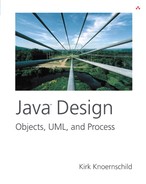Book Description
Software designers, developers, and architects are constantly confronted with the same confounding problem: how to design software that is both flexible and resilient amid change. To accomplish this tall task, practitioners must utilize the best available technologies to the fullest.
Java™ Design relies on a combination of best practices and best-of-breed technologies to create a clear and concise guide to building high-quality, lasting software designs. In particular, the author provides unique insight into using the Unified Modeling Language (UML) to develop Java applications.
The first half of the book focuses on the software process and how UML, Java technology, and object-oriented programming can be used effectively. The advantages of each technology are enumerated, highlighting common principles. Also included are in-depth discussions of design patterns, the Unified Process, and Extreme Programming.
The second half of the book describes how these complementary technologies can be used together as a system of checks and balances to ensure successful creation of high-quality software. You'll also find details on modeling strategies, a phased approach to adopting each of the technologies outlined, and the design of subsystems.
Key topics include:
Object-oriented principles and patterns
UML and the role of modeling
UML and the software process, including best practices and lifecycle development
Modeling strategies and requirements
Behavioral modeling
Architectural modeling
Designing subsystems
Refactoring
Armed with a fresh perception of current design tools, this book will give you a deeper understanding of how to design cleaner Java applications using UML. Learn how you can expand your developer's toolkit using existing technologies in new ways--and create better software.
0201750449B11262001
Table of Contents
- Copyright
- PREFACE
- INTRODUCTION
- OO Principles and Patterns
- Introduction to the UML
- Fundamental UML
- The UML and Software Process
- Modeling Strategies
- Requirements Modeling
- Problem Analysis
- Behavioral Modeling
- Structural Modeling
- Architectural Modeling
- Designing Subsystems
- Rational Unified Process (RUP) and Extreme Programming (XP)
- J2EE and the UML
- Code Listing for UML Exercise
- Bibliography
